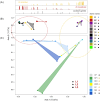Comprehensive survey of kombucha microbial communities of diverse origins and fermentation practices
- PMID: 39904552
- PMCID: PMC11851468
- DOI: 10.1093/femsyr/foaf005
Comprehensive survey of kombucha microbial communities of diverse origins and fermentation practices
Abstract
Kombucha is a unique, naturally fermented sweetened tea produced for thousands of years, relying on a symbiotic microbiota in a floating biofilm, used for successive fermentations. The microbial communities consist of yeast and bacteria species, distributed across two phases: the liquid and the biofilm fractions. In the fermentation of kombucha, various starters of different shapes and origins are used, and there are multiple brewing practices. By metabarcoding, we explored here the consortia and their evolution from a collection of 23 starters coming from various origins summarizing the diversity of kombucha fermentation processes. A core microbiota of yeast and bacteria has been identified in these diverse kombucha symbiotic consortia, revealing consistent core taxa across symbiotic consortium of bacteria and yeasts from different starters. The common core consists of five taxa: two yeast species from the Brettanomyces genus (B. bruxellensis and B. anomalus) and bacterial taxa Komagataeibacter, Lactobacillus, and Acetobacteraceae, including the Acetobacter genus. The distribution of yeast and bacteria core taxa differs between the liquid and biofilm fractions, as well as between the "mother" and "daughter" biofilms used in successive fermentations. In terms of microbial composition, the diversity is relatively low, with only a few accessory taxa identified. Overall, our study provides a deeper understanding of the core and accessory taxa involved in kombucha fermentation.
Keywords: bacteria; cores; fermentations; symbiotic; taxa; yeasts.
© The Author(s) 2025. Published by Oxford University Press on behalf of FEMS.
Conflict of interest statement
F.F. and O.C. are the owners of the company Bio Brasseurs. The remaining authors declare that the research was conducted in the absence of any commercial or financial relationships that could be construed as a potential conflict of interest.
Figures






Similar articles
-
A tale of two vineyards: parsing site-specific differences in bacterial and fungal communities of wine grapes from proximal vineyards and their changes during processing in a single winery.Appl Environ Microbiol. 2025 Jun 18;91(6):e0052625. doi: 10.1128/aem.00526-25. Epub 2025 May 5. Appl Environ Microbiol. 2025. PMID: 40323100 Free PMC article.
-
Tailor-made microbial consortium for Kombucha fermentation: Microbiota-induced biochemical changes and biofilm formation.Food Res Int. 2021 Sep;147:110549. doi: 10.1016/j.foodres.2021.110549. Epub 2021 Jun 18. Food Res Int. 2021. PMID: 34399526
-
Changes in microbial community structure during adaptation of kombucha symbiotic culture of bacteria and yeast to fermentation of sweet and acid whey.J Dairy Sci. 2025 May;108(5):4761-4784. doi: 10.3168/jds.2024-25859. Epub 2025 Mar 4. J Dairy Sci. 2025. PMID: 40049406
-
Thriving in Adversity: Yeasts in the Agave Fermentation Environment.Yeast. 2025 Jan;42(1-3):16-30. doi: 10.1002/yea.3989. Epub 2025 Feb 19. Yeast. 2025. PMID: 39967574 Free PMC article. Review.
-
Understanding Kombucha Tea Fermentation: A Review.J Food Sci. 2018 Mar;83(3):580-588. doi: 10.1111/1750-3841.14068. J Food Sci. 2018. PMID: 29508944 Review.
References
-
- Andreson M, Kazantseva J, Kuldjärv R et al. Characterisation of chemical, microbial and sensory profiles of commercial kombuchas. Int J Food Microbiol. 2022;373:109715. - PubMed
-
- Callanan M, Naranjo DR, McAuliffe O. 1.10—Genomic insights into food fermentations. In: Cifuentes A (ed.), Comprehensive Foodomics. Oxford: Elsevier, 2021,160–70.
-
- Coton M, Pawtowski A, Taminiau B et al. Unraveling microbial ecology of industrial-scale kombucha fermentations by metabarcoding and culture-based methods. FEMS Microbiol Ecol. 2017;93:fix048. - PubMed
-
- de Miranda JF, Ruiz LF, Silva CB et al. Kombucha: a review of substrates, regulations, composition, and biological properties. J Food Sci. 2022;87:503–27. - PubMed
MeSH terms
Substances
Grants and funding
LinkOut - more resources
Full Text Sources

